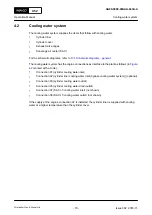
3.3
The relation between engine and propeller
3.3.1
General
There is a specified relation between the propeller speed and the absorbed power in ships that
have fixed pitch propellers. The relation is between the propeller and the speed at which it turns.
The formula that follows (where P = power and n = speed) gives an approximate result, which is
sufficient for conventional vessels:
The graph from this formula is known as the propeller property.
If the engine is in good condition, correctly supplied with air (ie turbochargers in good condition
and the resistance of the air and exhaust pipes is in the specifications) and the fuel injection
quantity is correctly adjusted (see the shop test protocol), then the mean effective pressure (MEP)
developed during service conditions (in accordance with the specified load indication), is related
to the approximate MEP for this position on the test bed.
In the diagram (see
), the propeller property line through the CMCR point (100% power
at 100% engine speed) is known as the nominal propeller property. Engines that are used for the
propulsion of vessels with fixed propellers have a load applied on the test bed in accordance with
this propeller property. But, during sea trial of a new ship with a smooth and clean hull, the
applicable power is lower and the operation point is below the nominal propeller property.
During operation, a higher torque is necessary for the propeller to keep its speed than at the time
of the sea trial (sea margin) because:
•
There are changes in wake flow conditions because of marine growth on the hull
•
The cargo load has an effect on the depth of the vessel in the water
•
The propeller has a rough surface or has mechanical damage
•
The vessel operates in bad sea and weather conditions
•
The vessel operates in shallow water. The MEP of the engine (and thus the fuel injection
quantity) will increase. In such a condition, the operation point will then be at the left of the
initial propeller curve which was calculated during sea trials.
A hull that was cleaned and painted will help to decrease the resistance as the vessel moves
through the water. It is not possible to get the hull back to its initial condition.
Because the thermal load of the engine is related to the MEP, the position of the operation point
is also important. The air supply to the engine and the operation conditions will become
unsatisfactory if the operation point is far above the propeller curve.
To get the best conditions, the operation point of the engine for service range must be on or below
the nominal propeller property.
X52
AA00-0000-00AAA-042B-A
Operation Manual
The relation between engine and propeller
Winterthur Gas & Diesel Ltd.
- 62 -
Issue 002 2018-11
















































